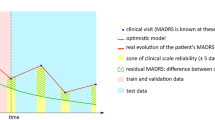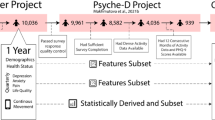Abstract
Mental disorders like depression represent 28% of global disability. It affects around 7.5% percent of global disability. Depression is a common disorder that affects the state of mind, normal activities, emotions, and produces sleep disorders. It is estimated that approximately 50% of depressive patients suffering from sleep disturbances. In this paper, a data mining process to classify depressive and not depressive episodes during nighttime is carried out based on a formal method of data mining called Knowledge Discovery in Databases (KDD). KDD guides the process of data mining with stages well established: Pre-KDD, Selection, Pre-processing, Transformation, Data Mining, Evaluation, and Post-KDD. The dataset used for the classification is the DEPRESJON dataset, which contains the motor activity of 23 unipolar and bipolar depressed patients and 32 healthy controls. The classification is carried out with two different approaches; a multivariate and univariate analysis to classify depressive and non-depressive episodes. For the multivariate analysis, the Random Forest algorithm is implemented with a model construct of 8 features and, results of the classification are; specificity equal to 0.9927 and sensitivity equal to 0.9991. The univariate analysis shows that the maximum in time of the activity is the most descriptive characteristic of the model with 0.908 in accuracy for the classification of depressive episodes.





Similar content being viewed by others
REFERENCES
Organization, W.H., et al., Depression and other common mental disorders: global health estimates, Tech. Rep., World Health Organization, 2017.
Espinosa-Aguilar, A., Caraveo-Anduaga, J., Zamora-Olvera, M., Arronte-Rosales, A., Krug-Llamas, S., Olivares-Santos, E., Reyes-Morales, R., Tapia-García, H., García-González, M., Doubova, J., et al., Guía de práctica clínica para el diagnóstico y tratamiento de depresión en los adultos mayores, Salud Mental, 2007, vol. 30, no. 6, pp. 69–80.
Montgomery, S.A. and Åsberg, M., A new depression scale designed to be sensitive to change, Br. J. Psychiatry, 1979, vol. 134, no. 4, pp. 382–389.
Fierro, M., Bustos, A., and Molina, C., Diferencias en la experiencia subjetiva entre depresión unipolar y bipolar, Revista Colombiana de Psiquiatría, 2016, vol. 45, no. 3, pp. 162–169.
García-Ceja, E., Riegler, M., Jakobsen, P., Tørresen, J., Nordgreen, T., Oedegaard, K.J., and Fasmer, O.B., Depresjon: a motor activity database of depression episodes in unipolar and bipolar patients, Proc. 9th ACM Multimedia Systems Conf., Amsterdam, 2018, pp. 472–477.
Association, A.P., et al., Diagnostic and statistical manual of mental disorders (DSM-5R©), American Psychiatric Pub., 2013.
Armitage, R., Sleep and circadian rhythms in mood disorders, Acta Psychiatr. Scand., 2007, vol. 115, pp. 104–115.
Koffel, E., Polusny, M.A., Arbisi, P.A., and Erbes, C.R., Predeployment day time and nighttime sleep complaints as predictors of post-deployment ptsd and depression in national guard troops, J. Anxiety Disord., 2013, vol. 27, no. 5, pp. 512–519.
Wichniak, A., Wierzbicka, A., Walecka, M., and Jernajczyk, W., Effects of antidepressants on sleep, Curr. Psychiatry Rep., 2017, vol. 19, no. 9, p. 63.
Kuhs, H. and Reschke, D., Psychomotor activity in unipolar and bipolar depressive patients, Psychopathology, 1992, vol. 25, no. 2, pp. 109–116.
Fang, H., Tu, S., Sheng, J., and Shao, A., Depression in sleep disturbance: a review on a bidirectional relationship, mechanisms and treatment, J. Cell. Mol. Med., 2019, vol. 23, no. 4, pp. 2324–2332.
Osmani, V., Smartphones in mental health: detecting depressive and manic episodes, IEEE Pervasive Comput., 2015, vol. 14, no. 3, pp. 10–13.
Zanella-Calzada, L.A., Galván-Tejada, C.E., Chávez-Lamas, N.M., Gracía-Cortés, M., Magallanes-Quintanar, R., Celaya-Padilla, J.M., Galván-Tejada, J.I., and Gamboa-Rosales, H., Feature extraction in motor activity signal: towards a depression episodes detection in unipolar and bipolar patients, Diagnostics, 2019, vol. 9, no. 1, p. 8.
Clark, A., The machine learning audit – crisp-dm framework, ISACA J., 2018, vol. 1, pp. 1–6.
Dåderman, A. and Rosander, S., Evaluating frameworks for implementing machine learning in signal processing: a comparative study of crisp-dm, semma and kdd, Kandidat-uppsats från KTH, Skolan för elektroteknik och datavetenskap (EECS), 2018.
Palacios, H.J.G., Pantoja, G.A.H., Navarro, A.A.M., Puetaman, I.M.A., and Toledo, R.A.J., Comparativa entre crisp-dm y semma para la limpieza de datos en productos modis en un estudio de cambio de cobertura y uso del suelo: comparative between crisp-dm and semma for data cleaning of modis products in a study of land use and land cover change, Proc. 11th IEEE Colombian Computing Conf. (CCC), Medellin, 2016, pp. 1–9.
Luis Fernando, C., Esperanza, E., and Andrés Felipe, M., Applying crisp-dm in a kdd process for the analysis of student attrition, in Proc. Colombian Conf. on Computing, Springer, 2018, pp. 386–401.
Fayyad, U., Piatetsky-Shapiro, G., and Smyth, P., From data mining to knowledge discovery in databases, AI Mag., 1996, vol. 17, no. 3, p. 37.
Ferenchick, E.K., Ramanuj, P., and Pincus, H.A., Depression in primary care: part 1 – screening and diagnosis, BMJ [Br. Med. J.], 2019, vol. 365, p. l794.
Barnett, A., Zhang, C.J., Johnston, J.M., and Cerin, E., Relationships between the neighborhood environment and depression in older adults: 8a systematic review and metaanalysis, Int. Psychogeriatrics, 2018, vol. 30, no. 8, pp. 1153–1176.
Maji, S., Society and ‘good woman’: a critical review of gender difference in depression, Int. J. Soc. Psychiatry, 2018, vol. 64, no. 4, pp. 396–405.
Hollis, C., Depression, family environment, and adolescent suicidal behavior, J. Am. Acad. Child Adolesc. Psychiatry, 1996, vol. 35, no. 5, pp. 622–630.
Kotiaho, S., Korniloff, K., Vanhala, M., Kautiainen, H., Koponen, H., Ahonen, T., and Mäntyselkä, P., Psychiatric diagnosis in primary care patients with increased depressive symptoms, Nord. J. Psychiatry, 2019, vol. 73, no. 3, pp. 195–199.
Evans-Lacko, S. and Knapp, M., Cost of Depression in the Workplace across Eight Diverse Countries – Collectively us $250 Billion, LSE Health and Social Care, 2016.
Schuch, F.B., Vancampfort, D., Firth, J., Rosenbaum, S., Ward, P.B., Silva, E.S., Hallgren, M., Ponce De Leon, A., Dunn, A.L., Deslandes, A.C., et al., Physical activity and incident depression: a meta-analysis of prospective cohort studies, Am. J. Psychiatry, 2018, vol. 175, no. 7, pp. 631–648.
Gruenerbl, A., Osmani, V., Bahle, G., Carrasco, J.C., Oehler, S., May-ora, O., Haring, C., and Lukowicz, P., Using smartphone mobility traces for the diagnosis of depressive and manic episodes in bipolar patients, Proc. 5th ACM Augmented Human Int. Conf., Kobe, 2014, p. 38.
Murphy, M.J. and Peterson, M.J., Sleep disturbances in depression, Sleep Med. Clin., 2015, vol. 10, no. 1, pp. 17–23.
Guglielmi, O., Magnavita, N., and Garbarino, S., Sleep quality, obstructive sleep apnea, and psychological distress in truck drivers: a cross-sectional study, Soc. Psychiatry Psychiatr. Epidemiol., 2018, vol. 53, no. 5, pp. 531–536.
Srinivasan, R., Chen, C., and Cook, D., Activity recognition using actigraph sensor, Proc. 4th Int. Workshop on Knowledge Discovery from Sensor Data (ACM Sensor KDD’10), Washington, July, 2010, pp. 25–28.
Garcia-Ceja, E., Riegler, M., Jakobsen, P., Torresen, J., Nordgreen, T., Oedegaard, K.J., and Fasmer, O.B., Motor activity based classification of depression in unipolar and bipolar patients, Proc. 31st IEEE Int. Symp. on Computer-Based Medical Systems (CBMS), Karlstad, 2018, pp. 316–321.
Ravi, N., Dandekar, N., Mysore, P., and Littman, M.L., Activity recognition from accelerometer data, AAAI, 2005, vol. 5, pp.1541–1546.
Galván-Tejada, C., García-Vázquez, J., and Brena, R., Magnetic field feature extraction and selection for indoor location estimation, Sensors, 2014, vol. 14, no. 6, pp. 11 001–11 015.
Granitto, P.M., Furlanello, C., Biasioli, F., and Gasperi, F., Recursive feature elimination with random forest for ptr-ms analysis of agroindustrial products, Chemom. Intell. Lab. Syst., 2006, vol. 83, no. 2, pp. 83–90.
Kotsiantis, S., Kanellopoulos, D., Pintelas, P., et al., Handling imbalanced datasets: a review, GESTS Int. Trans. Comput. Sci. Eng., 2006, vol. 30, no. 1, pp. 25–36. [35] Castelli, M., Vanneschi, L., and ́ Largo, Á.R., Supervised learning: classification, in Encyclopedia of Bioinformatics and Computational Biology, Ranganathan, S., Gribskov, M., Nakai, K., and Schönbach, C., Eds., Elsevier, 2019, vol. 1–3, pp. 342–349.
Vijayashree, J. and Sultana, H.P., A machine learning framework for feature selection in heart disease classification using improved particle swarm optimization with support vector machine classifier, Program. Comput. Software, 2018, vol. 44, no. 6, pp. 388–397.
Jayashree, J. and Kumar, S.A., Linear discriminant analysis bsed genetic algorithm with generalized regression neural network – a hybrid expert system for diagnosis of diabetes, Program. Comput. Software, 2018, vol. 44, no. 6, pp. 417–427.
Shatte, A.B., Hutchinson, D.M., Teague, S.J., Machine learning in mental health: a scoping review of methods and applications, Psychol. Med., 2019, vol. 49, no. 9, pp. 1426–1448.
Kasthurirathne, S.N., Biondich, P.G., Grannis, S.J., Purkayastha, S., Vest, J.R., and Jones, J.F., Identification of patients in need of advanced xare for depression using data extracted from a statewide health information exchange: a machine learning approach, J. Med. Internet Res., 2019, vol. 21, no. 7, p. e13809.
Pacheco-González, S.L., Zanella-Calzada, L.A., Galván-Tejada, C.E., Chávez-Lamas, N.M., Rivera-Gómez, J.F., and Galván-Tejada, J.I., Evaluation of five classifiers for depression episodes detection, Res. Comput. Sci., 2019, vol. 148, pp. 129–138.
Frogner, J.I., Noori, F.M., Halvorsen, P., Hicks, S.A., Garcia-Ceja, E., Torresen, J., and Riegler, M.A., One-dimensional convolutional neural networks on motor activity neasurements in detection of depression, Proc. 4th Int. Workshop on Multimedia for Personal Health & Health Care, Nice, Oct. 2019, pp. 9–15.
Rodríguez-Ruiz, J.G., Galván-Tejada, C.E., Zanella-Calzada, L.A., Celaya-Padilla, J.M., Galván-Tejada, J.I., Gamboa-Rosales, H., and Soto-Murillo, M.A., Comparison of night, day and 24 h motor activity data for the classification of depressive episodes, Diagnostics, 2020, vol. 10, no. 3, p. 162.
Vychegzhanin, S.V., Razova, E.V., and Kotelnikov, E.V., What number of features is optimal: a new method based on approximation function for stance detection task, Proc. 9th Int. Conf. on Information Communication and Management, Prague, Aug. 2019, pp. 43–47.
Garcia-Ceja, E., Riegler, M., Jakobsen, P., Torresen, J., Nordgreen, T., Oedegaard, K.J., and Bernt Fasmer, O., Depresjon: a motor activity database of depression episodes in unipolar and bipolar patients, 2018. https://datasets.simula.no/depresjon/.
Author information
Authors and Affiliations
Corresponding authors
Rights and permissions
About this article
Cite this article
Rodríguez-Ruiz, J.G., Galván-Tejada, C.E., Vázquez-Reyes, S. et al. Classification of Depressive Episodes Using Nighttime Data; a Multivariate and Univariate Analysis. Program Comput Soft 46, 689–698 (2020). https://doi.org/10.1134/S0361768820080198
Received:
Revised:
Accepted:
Published:
Issue Date:
DOI: https://doi.org/10.1134/S0361768820080198




